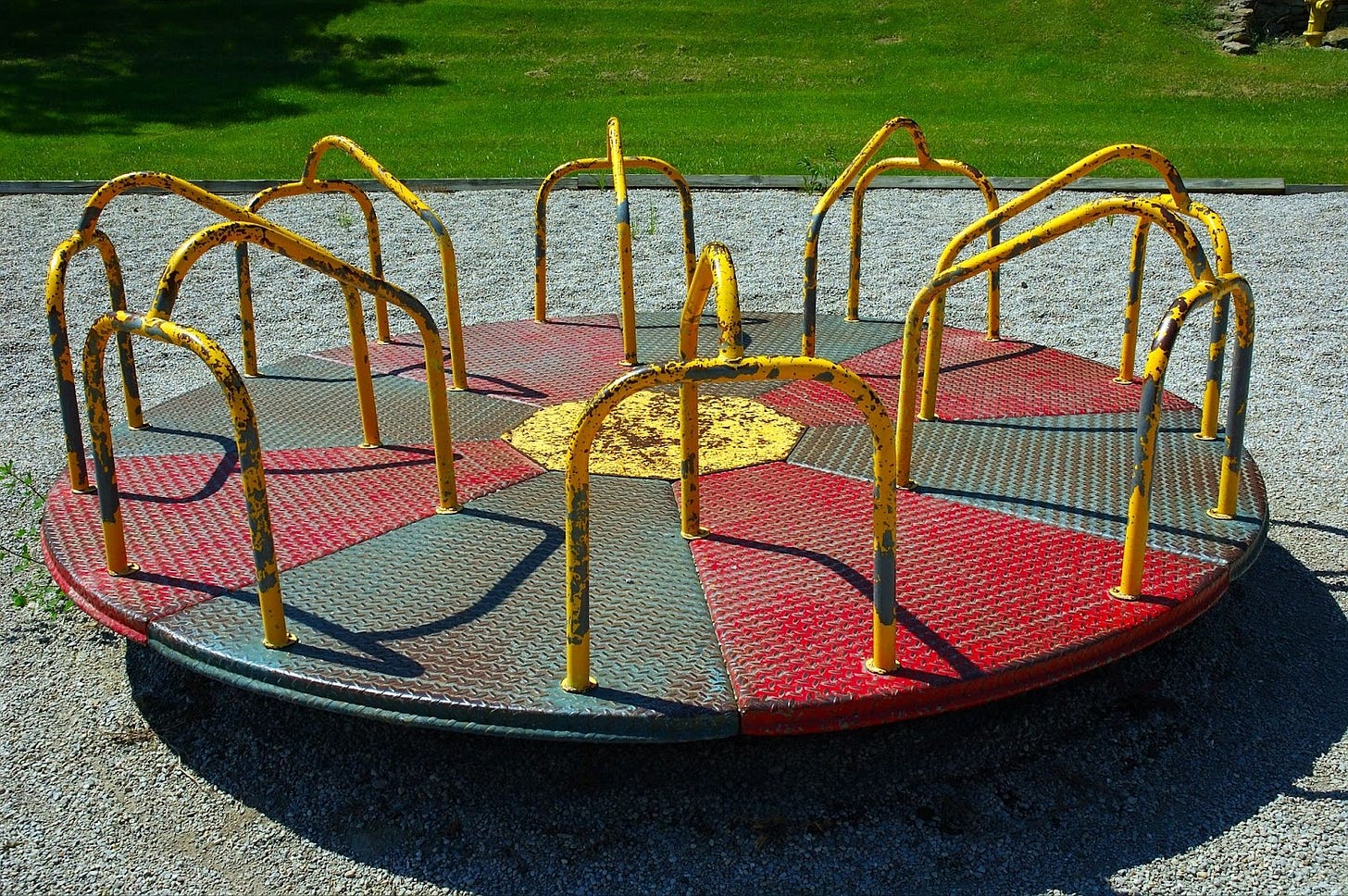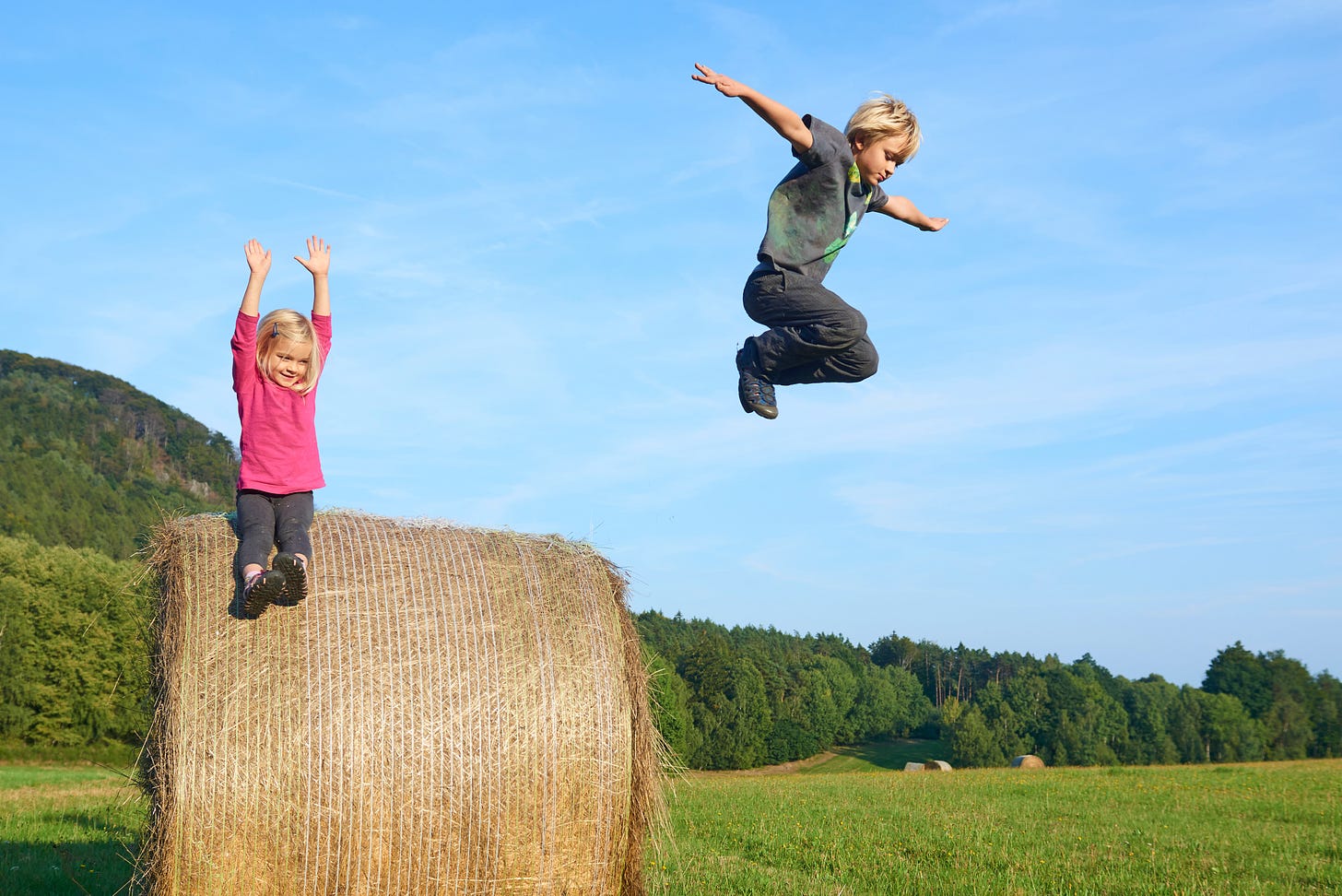A Norwegian Approach to Supporting Children’s Risky Play
Ellen Sandseter on the value of bumps, bruises, and building real-world confidence
Intro from Zach Rausch and Jon Haidt:
As we work to make the online world safer for kids, we must also ensure that the real world becomes more inviting—full of adventure, joy, and meaningful independence. In some places, this may simply mean delaying access to devices and apps. In others, it will take more creativity and cultural change.
Few people are better equipped to guide us in this effort than Dr. Ellen Sandseter, a leading global expert on risky play. Ellen is a professor at Queen Maud University College of Early Childhood Education in Trondheim, Norway, and a close collaborator of Mariana Brussoni—who wrote one of our most important essays on risky play for After Babel last year. Ellen’s work was recently highlighted in Nature for its insight into why kids need risky play, and how parents can help make it happen.
Her research is at the heart of Chapter 3 of The Anxious Generation, where we introduce the six types of risky play she identified: (1) play at great heights, (2) play at high speed, (3) play with dangerous tools, (4) play near dangerous elements, (5) rough-and-tumble play, and (6) play where children explore alone. In that chapter, Jon offers practical suggestions for redesigning public spaces and playgrounds to support these forms of play. He even makes the case that the playground spinner (see image below) is “in his humble opinion, the greatest playground equipment ever invented.” The more kids who join, the faster it spins. It demands cooperation, invites chaos and laughter, and offers endless opportunities for risk-taking.
In this post, Ellen offers a glimpse into how risky play thrives in Norway and outlines a path forward for those of us in the Anglosphere who are eager to restore a more vibrant real-world childhood.
– Zach and Jon
A Norwegian Approach to Supporting Children’s Risky Play
By Ellen Sandseter
Up in the Norwegian mountains where we have our family cabin, there’s a tall pine tree—about 10 to 15 meters high (roughly 40 to 50 feet). My son Simen, now ten years old, has spent years playing in that tree. He’s climbed its branches, built a treehouse, and leapt down from the limbs with the ease that comes from familiarity and practice. His younger sister, Sara, seven, had watched him do all of this with admiration, eager to follow in his footsteps.
At first, the branches were too high for her to reach. But by age five, with the help of a ladder, she managed to grab hold of the lowest branch. Her first climb stopped there. The next time, she made it to the second. After months of repeated play, Sara reached the third, and eventually, higher and higher. With each climb, she built not only skill but courage—learning to assess risk and manage it on her own terms. I watched as her competence and confidence grew—both on the way up and, importantly, on the way down.
One day, while I was painting the shed behind the cabin, I heard Sara’s voice call out: “Mom! Mom! Come look at me! I’m at the top of the tree!”
I walked around the cabin and looked up. There she was, high in the crown of the pine tree, standing on its upper branches.
“Stay right there!” I shouted. “I want to take a picture!”
I ran inside to grab my camera, snapped a photo, and went back to painting.
How did she get down? I don’t know. But I wasn’t worried. I had seen her gradually master the climb over time. She knew how to get down—safely, calmly, and on her own.
Why Risky Play Matters
In an After Babel post last year, Mariana Brussoni offered an excellent overview of what risky play is and why it’s so essential for children’s well-being, learning, and development. The growing body of research on risky play was also summarized in a recent Nature feature.
I’m a mother of two, an educator in early childhood training for over 25 years, and a researcher of children’s exploration, physical activity, and risk-taking. I grew up in one of Norway’s major cities, in a neighborhood where children roamed freely through streets and nearby forest patches. We played for hours, often wildly and with a fair amount of risk. On weekends, my parents took me hiking, skiing, and exploring the woods and coastlines. Those early experiences shaped my understanding of what children need to thrive.
As a mother, I’ve worked to give my own children, Simen and Sara (now 23 and 26), the same freedoms—to explore, to take risks, and to learn by testing their limits in real-world environments.
The Norwegian Approach to Risky Play
In Scandinavia, particularly in Norway, there is a more liberal approach to child-rearing compared to many Western countries. In her book Reclaiming Childhood, Helene Guldberg, who grew up in Norway and later lived in the UK, explores this cultural divide. She notes that Norwegians' deep love of the outdoors contributes to a parenting style that resists overprotectiveness. In contrast, Guldberg observed that UK parents often restricted children’s independence in the name of safety.
Similar trends have taken hold in the United States, as Jonathan Haidt documents in The Anxious Generation. Australia is following suit, and even within Europe, a north-south divide appears: Southern European countries tend to have more risk-averse parenting and educational practices.

The study which found this divide, comparing independent mobility across countries, showed that Greek children are typically allowed to walk to school or play unsupervised only between ages 11 and 13. In Norway, children gain that freedom as early as ages 5 to 8. In the U.S., the majority of parents of 9-11-year-old children do not allow them to walk alone to a friend's house or play unsupervised with a friend at the park.
In many Norwegian Kindergartens, even toddlers are encouraged to explore nature and manage risk independently. Visiting educators from the U.S. are often surprised, even shocked, by how much freedom Norwegian children are given to roam and play outdoors.
Why this cultural difference?
Part of the answer lies in friluftsliv, a uniquely Scandinavian philosophy that emphasizes life lived in the open air. It’s a cultural value rooted in the belief that experiencing nature, enduring the elements, and navigating challenges helps children build resilience and independence.
This perspective is reflected in national education policy. The Framework Plan for Kindergartens, which is grounded in the values of the UN Convention on the Rights of the Child, highlights outdoor play as essential. It states:
“Kindergartens shall help children to evaluate and master risky play through physical challenges.”
Educators are not just tasked with keeping children safe, but they’re expected to help children develop the ability to manage risk themselves.
Teacher training programs also emphasize this. Future educators spend significant time outdoors, building practical skills, gaining comfort in natural environments, and learning how to lead children through playful, meaningful, and sometimes risky experiences. As a result, the outdoor play environment becomes a central part of pedagogical practice, rich with opportunities for physical, social, and cognitive growth.
Norway’s healthcare system also supports this approach. Because medical care for children under 16 is fully covered by the state, parents are less financially burdened when injuries do happen. A broken arm or a few stitches don’t become a financial crisis, and this thus lowers the societal pressure to eliminate all risk from children’s play.
Still, Norway isn’t immune to global trends. Increasing media coverage of childhood injuries, stricter playground safety regulations, and a more institutionalized childhood have contributed to a slow drift toward caution. Outdoor play is in decline, even here.
As one Kindergarten manager put it:
“With today’s media environment, any incident could land you on the front page of a national or local newspaper. That makes people extra cautious. It affects how kids play—whether they’re allowed to climb trees, ride bikes, or use certain playground equipment.”
What Can You Do to Support Risky Play?
As someone who has spent more than two decades advocating for risky play, I find today’s climate deeply concerning. But I haven’t lost hope. Every day, I remain committed to fighting for children’s right to free, outdoor, and adventurous play.
Here’s what each of us can do:
If you’re a parent:
Let kids be kids, let them explore, let them have some unsupervised play time. And if you need to calm yourself down, spend time playing with your child in nature. Observe - at a distance - how they assess and manage risk. You may be surprised by how capable they are when you step back. As you watch them grow in confidence and judgment, your own comfort with risky play will grow, too—just as mine did, to the point where I didn’t have to watch Sara descend from the tall pine and could go back to my painting.
If you’re a teacher in a school or Kindergarten:
Start conversations with parents. Talk about what risky play is, why it matters, and how it benefits their child’s development. Discuss together how much risk is acceptable (and note that injuries are very rare!). When parents are part of the dialogue, they’re more likely to support your approach and less likely to assign blame if an accident occurs.
If you are involved in teacher training:
Don’t just talk about risky play—model it. Take your students outdoors. Let them climb trees, balance on logs, jump between rocks. Let them build fires, pitch shelters, and navigate uneven terrain. The more they engage in these experiences themselves, the more comfortable they’ll be facilitating them for children—and the more they’ll understand and enjoy the process.
If you’re a playground designer or landscape architect:
Design for challenge, not just safety. The European EN 1176 standard recognizes that:
“Risk-taking is an essential feature of play provision... Play provision should aim at managing the balance between the need to offer risk and the need to keep children safe from serious harm.”
Use tools like the ISO 4980:2023 standard and benefit-risk assessments with input from experts in play, safety, and education. Prioritize natural elements, large functional structures (like swings, slides, and climbing towers), and features (e.g., tables, storage houses, and wheeled play equipment) that promote physical exploration.
Conclusion
Children’s risk-taking is shaped by three key factors:
Risk willingness – their emotional openness to trying something risky
Risk assessment – their ability to judge whether something is safe enough
Risk handling – their actual performance in navigating the challenge
As adults—parents, educators, designers, and policymakers—we must understand these dynamics and reflect on our own ethics. Are we guided by a desire to avoid all harm, or by a commitment to foster growth and learning—even if it sometimes includes bumps and bruises?
A balanced approach is key. Shielding children from all risk deprives them of critical learning. Letting them face every danger without guidance is irresponsible. But giving them space to explore, with support and trust, helps them grow into resilient, capable, and independent individuals.







Nature + positive risk goes hand in hand - and it's truly a mindset that one must have. Not to shy away, but to embrace the elements. Similarly, in winter - we need to be outdoors, and get our dose of light, even when it's cloudy and gloomy, it's still 10x brighter than the average office. Thank you for this wonderful article Ellen!
Unless we again get OK with the idea of some children potentially getting hurt while playing, and (a tiny number) getting it worse, and that's an acceptable and necessary part of giving them human freedom, this ain't gonna be resolved.
It's more likely they'll be in full custody 24/7, with gps and cameras watching them, helicoptered by their parents everywhere, left to rot watching screens in some climate controlled padded room, than that they'll be left to be humans, exploring and risking, and discovering freedom again.